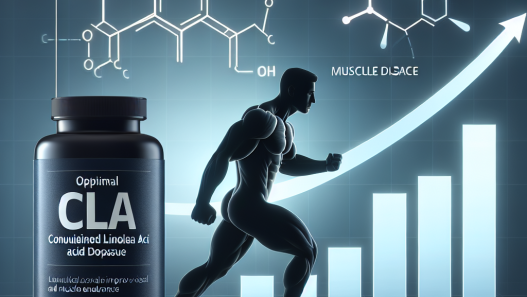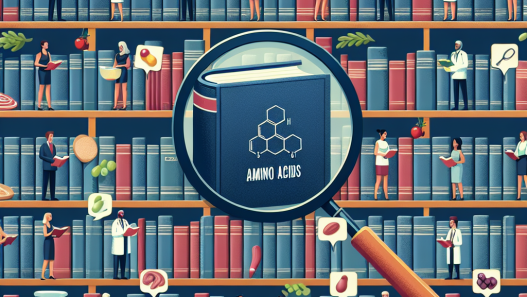-
Table of Contents
- Amino Acids in Athletes’ Nutrition: An In-Depth Analysis
- The Importance of Amino Acids in Athletes’ Nutrition
- The Different Types of Amino Acids and Their Functions
- Branched-Chain Amino Acids (BCAAs)
- Essential Amino Acids (EAAs)
- Non-Essential Amino Acids (NEAAs)
- The Benefits of Amino Acids for Athletes
- Improved Muscle Growth and Recovery
- Reduced Muscle Soreness
- Increased Endurance
- How to Incorporate Amino Acids into an Athlete’s Diet
- Conclusion
Amino Acids in Athletes’ Nutrition: An In-Depth Analysis
Athletes are constantly seeking ways to improve their performance and achieve their goals. From intense training regimens to specialized diets, athletes are always looking for that extra edge. One area that has gained significant attention in recent years is the use of amino acids in athletes’ nutrition. Amino acids are the building blocks of protein and play a crucial role in muscle growth and repair. In this article, we will take an in-depth look at the role of amino acids in athletes’ nutrition and the potential benefits they offer.
The Importance of Amino Acids in Athletes’ Nutrition
Protein is essential for athletes as it helps build and repair muscle tissue, which is crucial for improving performance and preventing injuries. Amino acids are the building blocks of protein, and there are 20 different types that the body needs to function properly. Of these 20, nine are considered essential, meaning that the body cannot produce them on its own and must obtain them through diet.
When an athlete engages in intense physical activity, their muscles experience micro-tears, which need to be repaired for the muscle to grow and become stronger. This is where amino acids come in. The body uses amino acids to repair and rebuild muscle tissue, making them an essential component of an athlete’s diet.
Furthermore, amino acids also play a crucial role in energy production. During exercise, the body uses glucose as its primary source of energy. However, as the intensity and duration of exercise increase, the body starts to use amino acids as an alternative source of energy. This is especially important for endurance athletes who engage in prolonged physical activity.
The Different Types of Amino Acids and Their Functions
As mentioned earlier, there are 20 different types of amino acids, each with its own unique function. However, for the purpose of this article, we will focus on the three main types that are of particular interest to athletes: branched-chain amino acids (BCAAs), essential amino acids (EAAs), and non-essential amino acids (NEAAs).
Branched-Chain Amino Acids (BCAAs)
BCAAs are a group of three essential amino acids: leucine, isoleucine, and valine. These amino acids are unique because they are metabolized directly in the muscles, rather than in the liver like other amino acids. This means that they can be used as a source of energy during exercise, making them particularly beneficial for endurance athletes.
BCAAs also play a crucial role in muscle protein synthesis, which is the process of building and repairing muscle tissue. Leucine, in particular, has been shown to stimulate muscle protein synthesis, making it a popular supplement among athletes looking to increase muscle mass and improve recovery.
Essential Amino Acids (EAAs)
As mentioned earlier, there are nine essential amino acids that the body cannot produce on its own and must obtain through diet. These include leucine, isoleucine, and valine (BCAAs), as well as histidine, lysine, methionine, phenylalanine, threonine, and tryptophan.
EAAs are crucial for muscle growth and repair, as well as for the production of hormones and enzymes. They also play a role in immune function and energy production, making them essential for athletes looking to perform at their best.
Non-Essential Amino Acids (NEAAs)
Non-essential amino acids are those that the body can produce on its own, so they are not considered essential in the diet. However, this does not mean that they are not important. NEAAs play a crucial role in various bodily functions, including tissue repair, hormone production, and immune function.
One NEAA that has gained significant attention in the world of sports nutrition is glutamine. Glutamine is the most abundant amino acid in the body and is essential for immune function and gut health. It has also been shown to improve muscle recovery and reduce muscle soreness, making it a popular supplement among athletes.
The Benefits of Amino Acids for Athletes
Now that we have a better understanding of the different types of amino acids and their functions, let’s take a closer look at the potential benefits they offer for athletes.
Improved Muscle Growth and Recovery
One of the most significant benefits of amino acids for athletes is their ability to improve muscle growth and recovery. As mentioned earlier, amino acids are the building blocks of protein, and they play a crucial role in repairing and rebuilding muscle tissue. This is especially important for athletes who engage in intense training regimens that can cause muscle damage.
Studies have shown that supplementing with BCAAs and EAAs can increase muscle protein synthesis, leading to improved muscle growth and recovery (Shimomura et al. 2006). This can be particularly beneficial for athletes looking to increase muscle mass and improve their performance.
Reduced Muscle Soreness
Muscle soreness is a common side effect of intense physical activity, and it can significantly impact an athlete’s performance. However, studies have shown that supplementing with BCAAs and glutamine can reduce muscle soreness and improve recovery time (Legault et al. 2015). This can allow athletes to train harder and more frequently, leading to better performance.
Increased Endurance
As mentioned earlier, BCAAs can be used as a source of energy during exercise, making them particularly beneficial for endurance athletes. Studies have shown that supplementing with BCAAs can delay fatigue and improve endurance performance (Gualano et al. 2011). This can be especially beneficial for athletes participating in long-distance events such as marathons or triathlons.
How to Incorporate Amino Acids into an Athlete’s Diet
Now that we understand the benefits of amino acids for athletes, the next question is how to incorporate them into an athlete’s diet. While it is possible to obtain all essential amino acids through a well-balanced diet, some athletes may benefit from supplementing with specific amino acids.
BCAAs and EAAs are commonly available in supplement form and can be taken before, during, or after exercise to support muscle growth and recovery. Glutamine is also available as a supplement and is often taken before or after exercise to reduce muscle soreness and improve recovery.
It is essential to note that supplements should not be used as a replacement for a healthy and balanced diet. Athletes should aim to obtain most of their essential amino acids through whole foods such as lean meats, fish, eggs, and dairy products.
Conclusion
Amino acids play a crucial role in athletes’ nutrition, and their benefits cannot be overlooked

















